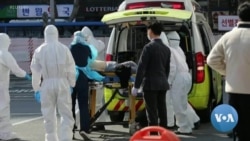Despite worldwide efforts to contain the new coronavirus, COVID-19 is now a pandemic. Health experts say community spread is happening in the U.S., and the known cases are just the tip of the iceberg.
When COVID-19 first erupted in China, infectious disease experts at hospitals in the U.S. took notice. At Ohio’s Cleveland Clinic, Dr. Robert Wyllie said the focus is on preparing health care workers.
“We’re updating the skills and knowledge of the caregivers,” he said. “That includes how to put on personal protective equipment and how to take off personal protective equipment so that you’re not contaminating yourself.”
MedStar Washington Hospital Center has been doing the same. The hospital has specialized rooms to treat patients with highly infectious diseases. But can any hospital really prepare for COVID-19?
“That’s a very difficult question to answer because it really depends on the demand,” said Dr. Glenn Wortmann, the hospital’s director of infection prevention. “If there’s a few patients, sure. If there’s a gazillion patients, there’s not a hospital in the world that’s ready for that.”
Virtual medicine
Some hospitals are exploring the idea of virtual visits via Skype or by phone. Dr. Stevan Whitt, the chief medical officer at the University of Missouri Health Care, is a fan.
“This is an excellent solution to both normal influenza season, as well as instances like COVID-19,” he said. “Patients can get quickly evaluated, get their questions answered, and we can get the sick patients that need to be in a hospital to a hospital, and we can keep the patients who don’t need to be in a hospital safe.”
Wortmann says other ideas include testing in designated areas outside the hospital.
“Eighty to 85% of patients who don’t need to be hospitalized can stay at home. So for those patients, that would be a very good idea to be able to test them, but then divert them from actually having to come into the hospital,” he said.
Faster testing
Wortmann says the CDC will soon allow hospitals to do their own testing, which will cut the turnaround time for test results from days to hours.
One of Wortmann’s biggest concerns is the safety of patients and staff in the emergency room.
“Preventing the spread of this virus within any organization is going to be a challenge,” he said. “It’s going to be in the absence of a vaccine, or in the absence of a treatment. It’s going to be old-school infection prevention.”








